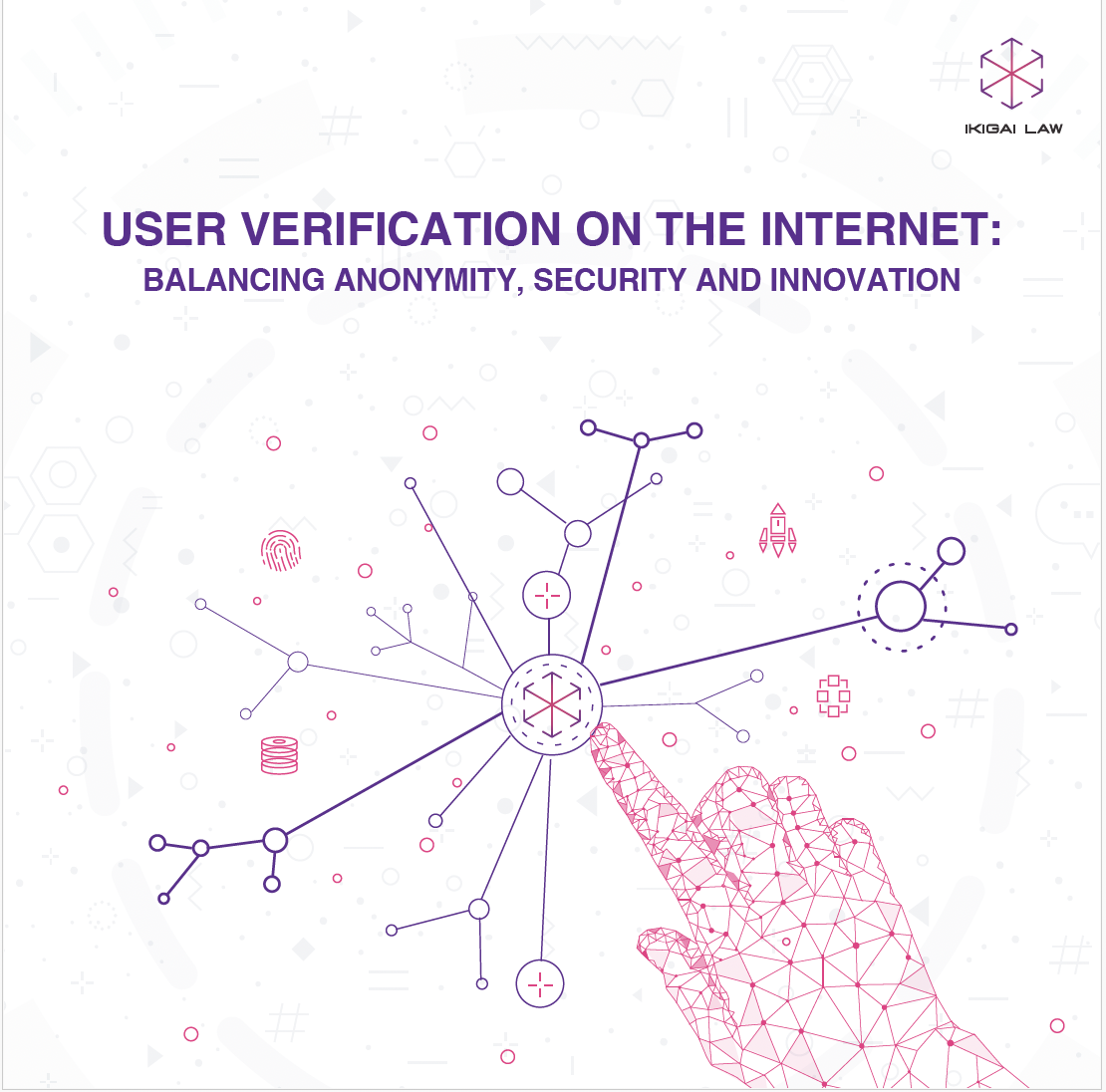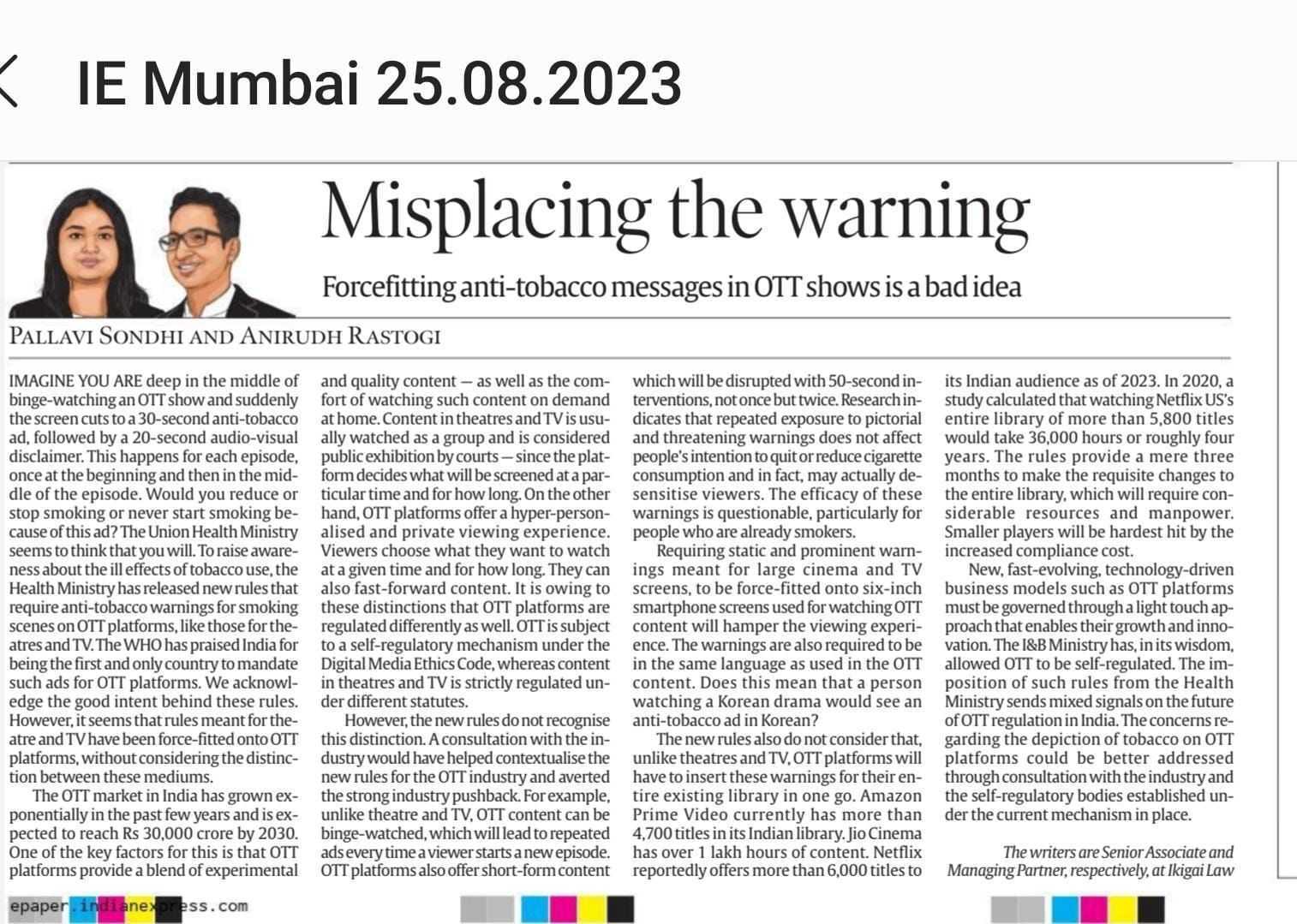1. Preliminary
Transparent stakeholder consultations allow non-governmental bodies like academic institutions, policy organisations, private companies and civil society organisations to participate in the policy drafting process. This makes the policy more comprehensive, and the policy-making process more transparent and inclusive. Conducting such stakeholder consultations sits at core of the Telecom Regulatory Authority of India’s (“TRAI”) responsibilities. Given the importance of these consultations, Vihang Jumle, associate at Ikigai Law, undertook a project to study instances where stakeholders were able to significantly influence TRAI’s views on issues relating to internet services through the public consultation process. This blog presents the key issues of 7 ‘closed consultations’ (consultation papers on which stakeholders have sent in their opinions and corresponding recommendations have been released) where the TRAI’s views did not change over the course of the consultation. For an explanation on the methodology and the scope of this project, click here.
2. Closed consultations that presented same ideas.
This section describes the key issues of 7 closed consultations where the TRAI’s views remained the same at the beginning and at the end of the consultation process.
2.1 Consultation paper on privacy, security and ownership of data in the telecom sector
This consultation paper was released in August 2017 and discussed measures to safeguard the privacy of telecom service users. The key issues discussed included: whether the definition of ‘data’ in the Indian context was comprehensive; the efficacy of prevailing data protection frameworks in India; the role of consent in the digital age; and data portability. 2015 to 2017 witnessed the creation of large volumes of user generated data which may have prompted the TRAI to proactively study the telecom landscape and start a conversation around data protection through this consultation paper. The recommendation paper associated with this consultation paper was released in July 2018.
2.1.1. Definition of personal data
The consultation paper discussed how advancements in digital technologies may have led to the creation of different kinds of data – some of which may constitute personal data – and questioned if the present definition of personal data under different data protection frameworks in India should be modified to make it more comprehensive. The consultation paper did not discredit the present definition of personal data in the Information Technology Act, 2000, but it did not also suggest that the present definition was complete. While taking a neutral stance on this issue, the TRAI invited stakeholder comments on the comprehensiveness of the definition of personal data in the Indian context.
TRAI in its recommendation paper concluded that the present definition of data used in the Indian context was comprehensive and did not need any major additions.
2.1.2. Data protection framework
The consultation paper discussed how different domains of the telecom industry in India employed different data protection frameworks (such as the Information Technology Act 2000, Indian Telegraph Act 1885, other supplementary rules and guidelines, etc.) and why a single all-encompassing data protection framework may be necessary to fill in existing gaps and avoid any exploitation of data. This consultation paper presented a set of 9 guiding principles for data protection that could be used as a starting point for examining if the existing Indian data protection frameworks were good enough. The consultation paper also stated that existing data protection frameworks in India needed updating to tackle potential privacy challenges posed by increased use of emerging technologies. The consultation paper invited comments from stakeholders on measures to encourage new data-based businesses in India that would be compliant with India’s data protection frameworks.
The recommendation paper concluded that the distributed system of data protection frameworks in India was not ideal and had many shortfalls. The TRAI in its recommendation paper suggested that all distributed data protection frameworks operating in India should be merged to form a single data protection framework. The recommendation paper discussed and endorsed ‘privacy by design’ – the concept that data-driven systems should be designed keeping the privacy of its users at the core – but had not discussed it in its consultation paper. The recommendation paper suggested that though it would be better to have a singular data protection framework, the telecom services providers should continue to adhere to the existing rules on data protection until such a singular data protection framework is formed in India.
2.1.3. Consent
The consultation paper discussed the current understanding of consent in the Information Technology Act, 2000 and questioned if this understanding needed modifications to better suit how user data would be used going ahead. The consultation paper observed that users often underestimate the long-term consequences of consenting to services and there was room for better methods of informing them of the same. The consultation paper hence examined if users’ consent should be taken before sharing their personal data for commercial purposes and what measures could be adopted to empower the users to take control over their personal data. It also questioned if it was advisable to create a technology-enabled architecture to audit the use of personal data and associated consent to avoid the exploitation of user data.
The TRAI in its recommendation paper stated that companies and service providers should add more granularity to their consent mechanisms and consent revocation policies. The recommendation paper placed sufficient importance on consent by recommending that the decryption of users’ data should be permitted only on a case-by-case basis and only after obtaining the consent of users. The use of pre-ticked boxes to obtain the consent of users should be prohibited. Electronic consent frameworks should also allow users to revoke their consent on a later date. Most recommendations made within the recommendation paper align with the ideas presented by TRAI in the consultation paper as.
2.1.4. Data portability
The consultation paper stated that the government should enable the industry to grow by the creation of new data-driven services. The consultation paper presented data portability – the ability to extract user data from a service and share it with another – as one “critical step” that may enable the government and companies to create new data-driven services. The consultation paper stated that new data-driven services are a global-trend and provide significant value to consumers and businesses.
The recommendation paper said that the “right to choice, notice, consent, data portability and right to be forgotten should be conferred upon the telecommunications consumers”. However, it further recommended that “the right to data portability and right to be forgotten are restricted rights and the same should be subjected to applicable restrictions due to the prevalent laws”. The recommendation paper also pointed out that many stakeholders advocated for data portability through their comments and said that it is a viable option that may enable businesses to create new data-based businesses and hence allow the TRAI to meet its objective. The ideas presented by TRAI in the consultation paper and the recommendation remained aligned and there was minimal deviation on what TRAI tried to convey through the consultation and the recommendation paper.
2.2 Consultation paper on proliferation of broadband through public Wi-Fi networks
This consultation paper was released in July 2016 and discussed the way in which the reach of broadband services can be increased in India through the expansion of public Wi-Fi services. It touched upon the current status of public Wi-Fi services in India and the issues associated with further increasing the reach of public Wi-Fi services. The consultation paper stated that increasing internet penetration in India will allow digital services in India to reach their peak potential and enable more Indians to derive the value of prevailing digital technologies. The key issues discussed within the consultation paper include: sharing of telecom infrastructure by telecom players; de-licensing of telecom spectrum; the use of one-time-passwords for authentication; and the costs associated with Wi-Fi stations. The recommendation paper was released in March 2017.
2.2.1. Infrastructure sharing
The consultation paper sought to identify different ways in which ubiquitous public Wi-Fi services could be deployed in India. On these lines the consultation paper suggested that internet service providers can share their infrastructure across various geographical locations to provide all users with ubiquitous Wi-Fi services for public use. The consultation paper laid out a schematic of how different telecom players could bring in interoperability within their infrastructure to enable a broad network of Wi-Fi service.
The recommendation paper maintained the same position as that in the consultation paper on infrastructure sharing and recommended that internet service providers should actively share infrastructure to provide their users with an omnipresent Wi-Fi range. The recommendation paper pushed for the creation of Wi-Fi hubs (that provide connectivity points between various Wi-Fi networks and the users’ home network) and Wireless Roaming Intermediary Exchange (developed by the Wireless Broadband Association) to manage interconnections, data clearing, financial clearing, exchange of information over clouds.
2.2.2. De-licensing of spectrum
The consultation paper cited its previous recommendation paper titled “Broadband India: Recommendations on accelerating growth of internet and broadband penetration” (released in April 2004) and reiterated that the delicensing 5.725 – 5.825 GHz spectrum band can further facilitate the deployment of wireless access technologies and increase the penetration of broadband services in India. The consultation paper stated that such de-licensing will enable users to access the radio spectrum without having to face hurdles that may be applicable over other spectrums. The consultation paper also noted that only some space within the spectrum was made available after the recommendations of April 2004.
The recommendation paper stated that while some stakeholders supported the idea of delicencing, others warned against it. The first set of stakeholders stated that the available spectrum should be utilised to its maximum capacity before tapping into the new spectrum. These stakeholders also stated that access to spectrum space was not an immediate bottleneck and hence there was no immediate need to delicense more spectrum. The other set of stakeholders stated that refraining from delicensing spectrum that has been delicensed in other jurisdictions may create roadblocks for some digital services that operate in other jurisdiction from flourishing in India. Despite the pushback from some stakeholders, the recommendation paper concluded that delicensing additional spectrum space could catalyse the market for public Wi-Fi and in turn increase internet penetration. Maintaining the same position as in the consultation paper, the recommendation papers suggested that the department of telecommunications (“DoT”) should re-visit TRAI’s earlier recommendations and reconsider de-licensing spectrum in the 7.725 – 5.825 GHz spectrum band. It also recommended that the decision on the allocation of E-band (71-76 GHz and 81-86 GHz) and V-band (57-64 GHz) to service providers should be expedited.
2.2.3. One-time passwords (“OTP”)
The consultation paper paid good heed to the use of OTP since they have been widely adopted in India. Though OTP makes the process of authentication simple and convenient, it does bring its own set of challenges. The consultation paper discussed numerous problems that users tend to face while using OTP to avail public Wi-Fi services. OTPs are often used as a means to verify users’ mobile numbers or to create temporary login credentials. However, poor telecom network services have often hindered users from receiving OTPs, hence disallowing them from availing such services. Similar problems are faced by foreign nationals due to problems with delivering SMSs to international numbers. The consultation paper suggested that different login options – classifying different types of users and having different means of authentication – may be adopted to fill in the gaps of using OTP.
The recommendation paper suggested that the existing requirement of authentication through OTP for each instance can be replaced with electronic-Know-Your-Customer (“eKYC”), electronic-Customer-Application-Form, and other electronic modes that can store the information of a user after the user logs into the system for the first time using OTP. The eKYC will facilitate the authentication of a user for future use of a service and hence eliminate the need to receive an OTP after the first log in. The recommendation paper suggested that the DoT, in consultation with security agencies, may also use Medium Access Control Address of devices and other mobile apps that store eKYC data to facilitate the authentication of a user. The recommendation paper further stated that this method may resolve the issues with making payments and hence create a frictionless usage experience.
2.2.4. Costs associated with setting up Wi-Fi stations
Though it is important to discuss the ways in which public Wi-Fi systems can be deployed to increase access to broadband services in India, TRAI also found it imperative to discuss how the costs associated with procuring Wi-Fi equipment by service providers can be brought down. The consultation paper noted that the internet service providers (“ISP”) will be required to set up a huge Wi-Fi infrastructure. Wi-Fi services make use of unlicensed spectrum, their instruments are cheaper and readily available and have generally lower maintenance cost, yet the TRAI in its consultation paper suggested that cost of setting up Wi-Fi stations should be brought down further.
The recommendation paper suggested that the import duty applicable on Wi-Fi access point equipment should be revised in coordination with the commerce ministry.
2.3 Consulting paper on promoting local telecom equipment manufacturing
This consultation paper was released in September 2017 and discussed the status of local telecom manufacturing in India. It discussed the present concerns of the local telecom manufacturing sector, the initiatives taken by the Indian government to boost local telecom manufacturing and laid out questions to stakeholders on how the present condition could be improved. Key issues discussed include: methods to increase domestic manufacturing of electronics and telecom equipment in India; and ways to leverage the Preferential Market Access policy. The recommendation paper for this consultation paper was released in August 2018.
2.3.1. Domestic manufacturing of electronics and telecom equipment
Not having enough oversight over the manufacturing sector was highlighted as an issue while discussing the ways in which local telecom manufacturing can be increased. The consultation paper suggested that local manufacturing in India needs to be strictly monitored at all times so that the government has enough time to course correct. The consultation paper described the various steps taken by the Indian government to promote local electronics manufacturing. It also pointed out that though many sectors, such as consumer electronics, mobile handsets, etc. have received investments, the telecom equipment sector had lacked sufficient investments in the recent past.
In line with the idea floated by TRAI in its consultation paper, the recommendation paper noted that indigenous telecommunications equipment manufacturing should be monitored by the DoT. It further recommended that a dedicated unit in the DoT should aid equipment design, development and manufacturing of electronics in India. TRAI recommended that the Telecom Equipment Manufacturing Council (body responsible for promoting R&D, standardisation, and telecom equipment manufacturing) should identify areas of priority within the telecom manufacturing sector. The recommendation paper further suggested for the creation of Telecom Research and Development Fund with an initial corpus of INR 1000 crore to promote research, innovation, standardisation, design, testing, certification and manufacturing. It also recommended the creation of Telecom Entrepreneurial Promotion Fund and Telecom Manufacturing Promotion Fund to address the issues faced by private sector players. The recommendation paper also pushed for setting up institutes offering specialisation in telecommunications technologies and incubation centres in India. These steps appear to be geared toward increasing the capacity of the local telecom manufacturing sector and attracting a steady stream of investments, all of which aligns with the suggestions made in the consultation paper.
2.3.2. Preferential Market Access Policy
In a bid to encourage local manufacturing of telecom equipment in India, the Indian government had formulated the preferential market access (“PMA”) policy in 2012. The PMA policy mandated a phased increase in procurement from domestic manufacturers of telecom equipment. The consultation paper noted that the PMA policy was effective in boosting the manufacturing in the LED sector but was not so effective in the telecom industry. It also asked stakeholders to elaborate upon the reasons that may have led the PMA policy to fail in telecom and what areas within the PMA policy may need changes.
With an intent to increase the utility of the PMA policy, the TRAI in its recommendation paper stated that the DoT should review the PMA policy and appoint a nodal officer in the DoT or the Telecommunications Engineering Centre to look into the cases related to lack of implementation of PMA policy. The recommendation paper also stated that telecom service providers should be provided with incentives should they deploy more than the amount of indigenous telecom products mandated in the PMA policy. The recommendation paper and the consultation paper both discussed ideas on the same line – to leverage the PMA policy to increase local telecom manufacturing – which may also indicate that most stakeholders view PMA policy as an effective tool to boost local telecom manufacturing.
2.4 Consultation paper on implementation model for BharatNet
This consultation paper was released in November 2015 and discussed the ways in which BharatNet project could be implemented in India. It provided an introduction of the BharatNet project and discussed different models that can be employed to implement it in India. It created a positive case for the Build-Own-Operate-Transfer (“BOOT”) model – proposing it as an alternative model – and pushed for its adoption. It also provided a birds-eye view of how different countries have gone about implementing such large-scale projects as a reference. The recommendation paper was released in February 2016.
2.4.1. BharatNet implementation models
Given the broad scope and size of the BharatNet project, the consultation paper described why it was important for the government to implement this project using public-private partnership (“PPP”) methods. On these lines, this consultation paper described the BharatNet-Central Public Sector Undertaking, state and private-led implementation models – all different kinds of PPP methods. The consultation paper cited the Report on National Optical Fibre Network and stated that the aforementioned models were first described in this report and may referred to for more understanding of the model. The consultation paper elaborated upon the BOOT model – another kind of PPP model – and presented it as a viable alternative to the existing PPP models. In addition to pooling in the challenges and advantages of the existing PPP model from the stakeholders, the consultation paper also focused on crowdsourcing the challenges and advantages of employing the BOOT model. The consultation paper also asked questions around the funding structure that may allow the agencies involved in the BharatNet project to stay afloat.
The recommendation paper presented ideas that completely aligned with those in the consultation paper. The recommendation paper said that the BOOT model (or a model that is similar to the BOOT model) be preferred over other models to implement BharatNet project in India. The recommendation paper said that “a public-private-partnership model that aligns private incentives with long term service delivery in the vein of the Build-Own-Operate-Transfer/Build-Operate-Transfer models of implementation be the preferred means of implementation”. The recommendation paper also elaborated upon the different steps and incentives that could be put in place that may ensure the smooth implementation of the BharatNet project.
2.5 Consulting paper on cloud computing
This consultation paper was released in June 2016 and majorly discussed the four topics within cloud computing: interoperability and quality of service; security over the cloud; the regulatory and legal framework for cloud services; and implementing cloud services in India. The recommendation paper was released in August 2017.
2.5.1. Cloud computing services in India
This consultation paper provided an overview of cloud computing services and how these services operate in India. It largely described: interoperability and quality of service; security over cloud; the regulatory and legal framework for cloud services; and implementing cloud services in India.
The consultation paper broadly described the present situation of cloud services in India and prevailing legislations that govern cloud services, in India and abroad. The approach of this consultation paper is descriptive and not analytical since it only paints a comprehensive picture of present cloud services in India but does not take a position or provide an opinion on the concerns that surround this industry. The consultation paper posed straightforward questions for the stakeholders to answer basis the context it provided without itself opining on any issue. The questions revolved around how cloud computing services can benefit e-commerce, social networks and expansion of digital services in India; how cloud computing may allow IT companies to save a part of their infrastructure budget; how do companies pick amongst a pool of cloud service providers; what regulatory provisions could be put in place to protect the rights of users availing cloud services, etc.
The recommendation paper was an apt representation of the comments made by different stakeholders. It provided recommendations for each of the 4 aforementioned sub-topics that the consultation paper discussed above.
2.6 Consulting paper on net neutrality
The pre-consultation paper was released in May 2016 and the consultation paper was released in January 2017. The consultation paper provided a background of what was discussed in the pre-consultation and described the meaning of net-neutrality. It further discussed what net-neutrality meant in the Indian context, what kind of traffic on the Indian internet may be hit by net-neutrality and the principles that govern net-neutrality in India. The key issues discussed included: how the pre-consultation was used to form the final consultation paper; the principle of non-discrimination; the scope of the non-discrimination principle and different internet traffic monitoring mechanisms. The recommendation paper was released in November 2017.
2.6.1. Pre-consultation
Prior to publishing the consultation paper on net neutrality, the TRAI had published a pre-consultation paper to crowdsource views on different issues pertaining to net neutrality. In the pre-consultation paper, the TRAI had discussed topics such as the definition of net neutrality, the importance of unrestricted access to the internet, etc. It also discussed the need to preserve national security and users’ privacy on the internet. The stakeholder comments to this pre-consultation paper were used to frame consultation questions for the subsequent consultation on net neutrality.
2.6.2. Principles of non-discrimination
Though the concept net neutrality – that all data on the internet be treated equally – and its implementation appeared simple and intuitive, the advent of emerging technologies and how they function has added more nuance to the issue. Earlier consumers of data on internet were humans because of which it was not necessary to study data consumption patterns and impose restrictions on consumers. However, things changed after new technologies such as IoT started interacting with data on the internet. Keeping this idea at the centre, the consultation paper asked the stakeholders about the services that should be excluded from the principle of net neutrality.
The recommendation paper noted that the terms of license agreements governing the provision of internet services in India should be amended to incorporate the principles of net neutrality with ‘appropriate exclusions and exceptions’. Floating the idea of building in appropriate exclusions and exceptions within the net neutrality principle indicates that the TRAI and various stakeholders acknowledged that novel methods will need to be devised to accommodate changing consumption patterns of consumers other than human beings. The recommendation reaffirmed that any discriminatory practises – such as throttling or differential pricing – that may restrict the access of information on the internet by a user is against the net neutrality principle. The recommendation paper further added that it is necessary to be specific about the scope of services that need to be covered within the ambit of the non-discriminatory principle. This reiterates concerns of changing internet data consumption patterns by emerging technologies and similar digital services. The recommendation paper also discussed the definition of the internet. It paper stated that while some stakeholders considered the current definition of internet to be sufficient, other stakeholders suggested that the internet needed to be redefined to separate different kinds of traffic – such as user traffic, automated services, devices and emergency services – on the internet.
2.6.3. Scope of non-discrimination principle
The consultation paper further discussed how specialised services (such as IoT, content delivery networks or virtual private networks) use the internet to provide their services and discussed if such ‘non-human’ data consumers should be considered a part of the internet traffic. With the increase in use of data on the internet by entities other than humans, it appears that the TRAI is concerned about the skewedness in data consumption patterns and is contemplating if the non-discriminatory principle – that is applicable to all human consumers – should be applicable to such services. Although the consultation paper took no position on whether such services should be excluded or included in the scope of internet traffic, it asked the stakeholders for their views on the same.
Building upon the concerns put out in the consultation paper and the comments of the stakeholders, the recommendation paper, after its examining the nature of such services, said that such specialised services should indeed be “explicitly excluded” from the principle of non-discrimination, except with some exemptions. This may indicate mounting pressure on TRAI from internet service providers who may have advocated for such services to be excluded from the scope of the non-discriminatory principle.
2.6.4. Monitoring mechanisms
Net neutrality plays a crucial role in allowing non-discriminatory access to all internet users. Accordingly, the consultation paper discussed ways to maintain a tighter check over internet access and service providers to identify violations of net neutrality and curb any existing non-discriminatory practises. The consultation paper sought recommendations on how to maintain net neutrality throughout the internet landscape in India.
Building upon the stakeholder comments, the recommendation paper stated that the DoT may establish a multi-stakeholder not-for-profit body to monitor the violation of non-discriminatory principle.
2.7 Consulting paper on internet telephony
This consultation paper was released in June 2016 and broadly discussed internet telephony; voice over IP technology; the prevailing regulatory and licensing framework in India; and the regulatory hurdles with the internet telephony. Key issues discussed included: if the quality of service should be set by the regulator or if it should be left for the market to decide; applicable interconnection charges in internet telephony; the numbering system for internet telephony; and access to emergency service over internet telephony. The recommendation paper was released in October 2017.
2.7.1. Quality of Service (“QoS”)
QoS is a key component in internet telephony. The QoS determines audio clarity levels, the connection time, the connection drop rates amongst many other parameters that all point at the level of ‘goodness’ of the service. In line with the concept, the consultation paper stated that the quality of speech is an important consideration for any communication service. It discussed if it was necessary for the regulator to pre-set a standard for QoS for communication services. While doing so may guarantee users with good QoS, providing pre-set standard for QoS may not viable with respect to small scale service providers. The consultation paper also discussed if the determination of QoS should be left to the market players. Though the consultation paper discussed both sides of the coin, it did not itself take a stance on the issue.
The recommendation paper subsequently suggested that QoS should be left for the market players to decide as against it being pre-set by the regulator. The recommendation appears to be an apt representation of the stakeholder comments that may have suggested for little to no regulation within the industry.
2.7.2. Interconnection charges
Since internet telephony allows for telephonic connections to be made between users of different telecom service providers and based in different countries, it remained unclear which entity would be responsible for compensating the interconnection charges. To address this issue, the consultation paper described the prevailing interconnection framework and the applicable charges. The consultation paper itself did not take a position or opine about which entity (the service provider of the call initiator or the service provider of the call receiver) should be liable to pay the interconnection charges.
The recommendation paper observed that internet telephony operates in the same way as a generic telephonic connection. Hence, there was no need to create a separate framework to govern payments or any other features of internet telephony. The recommendation paper hence stated that the service provider who is liable to pay the charges while making a generic telephonic call will be responsible to pay the interconnection charges in internet telephony.
2.7.3. Numbering
Normal phone calls (initiated by PSTN/PLMN networks) work on a system of numbering. A 10-digit number is used to identify the caller and receiver. Internet telephony, however, does not require a numbering system to identify the caller and a receiver. This creates ambiguity for internet access providers who provide both kinds of communication services (PSTN/PLMN network based and internet telephony). The consultation paper discussed if there was a need for a new numbering system (similar to that of PSTN/PLMN networks) that would make it intuitive for users to use internet telephony.
The recommendation paper stated that a numbering system must be adopted to facilitate internet telephony. It recommended that the 10-digit number required for internet telephony for a user should be the same as that of the user’s PSTN/PLMN 10-digit number to make calling intuitive. The recommendation paper put the onus on the telecom service provider to provide users with the same number to use both cellular mobile services (PSTN/PLMN network) and internet telephony.
2.7.4. Access to emergency services
Though cellular networks guarantee access to emergency services, such services may not always be accessible over internet telephony. The consultation paper discussed different ways in which emergency services can be accessed on internet telephony. It asked stakeholders for their views on mandating sharing of a users’ location information with police stations in case of emergencies. The consultation paper itself did not take a position on this suggestion.
The recommendation paper stated that the access service providers should be encouraged to facilitate the access to location information in case of emergencies but this should not be a mandatory provision. Internet telephony was a fairly new technology a few years ago and hence was not deemed to be reliable at all times. Mandating the provisioning of such emergency services may only add to the costs associated with internet telephony, making it expensive which may slow down its adoption. The TRAI appears to have acknowledged this limitation and hence has only asked for this service to be provided wherever and whenever possible. The recommendation paper further stated that internet telephony users should be informed about the limitation of providing emergency services.
3. Closed consultations that presented conflicting ideas.
One closed consultation paper – the National Telecom Policy 2018 – was found to have multiple instances of the TRAI changing its positions on key issues. The upcoming blog will present an analysis of what changed within this paper, why some stakeholders may have advocated for such changes during the consultation process and what may have led the TRAI to pay heed to the suggestions made by such stakeholders.
(Authored by Vihang Jumle, Associate, with inputs from Tuhina Joshi, Policy Associate at Ikigai Law.)










